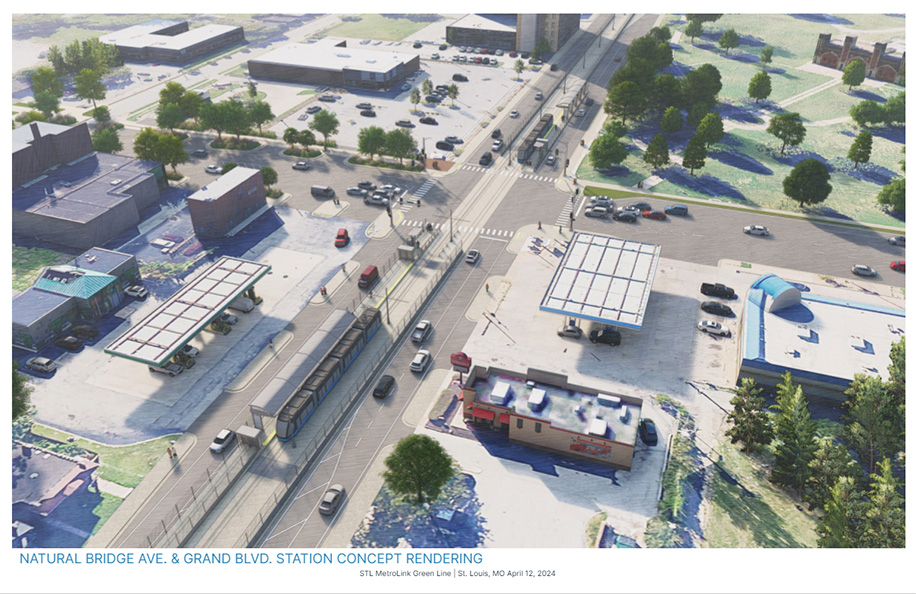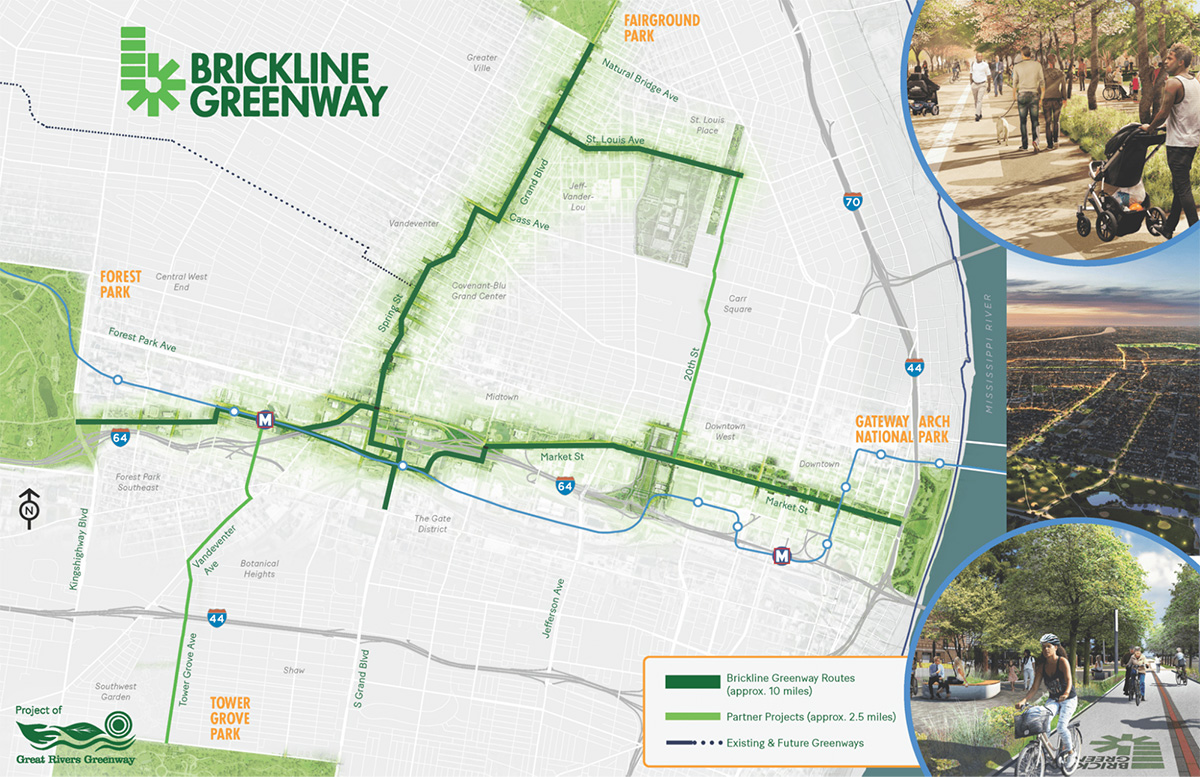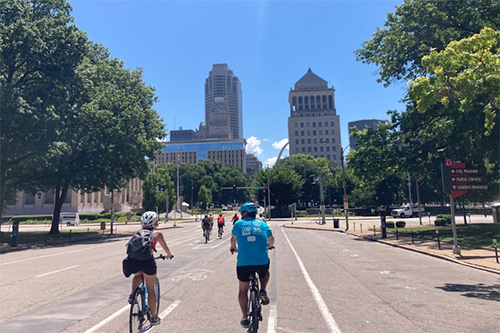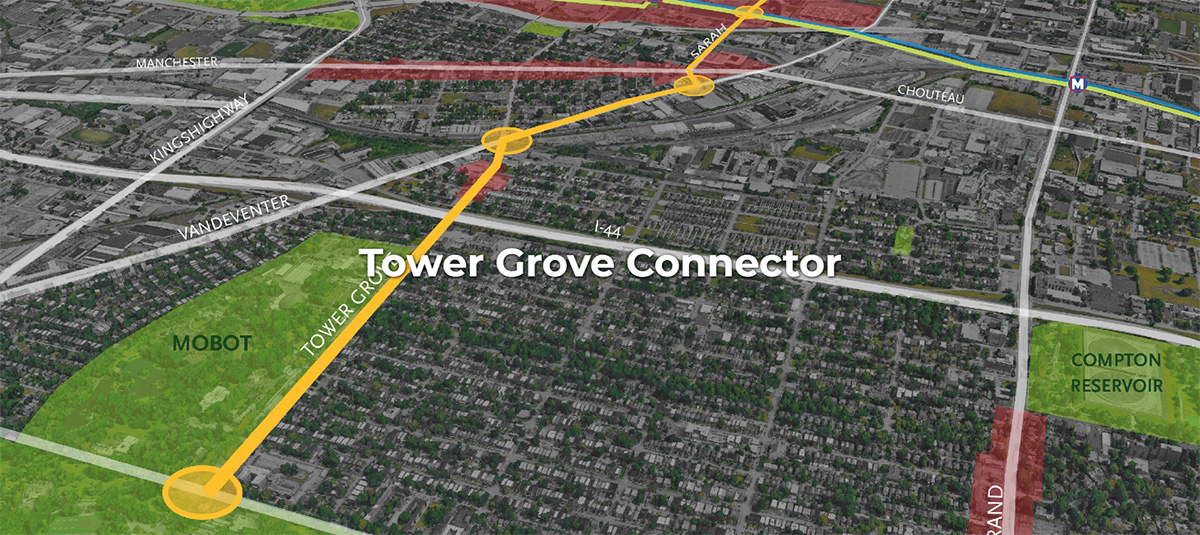Overview
Significant transportation infrastructure improvements are planned and underway throughout the City of St. Louis as a consequence of unprecedented investment in how we all get around for jobs, education, and enjoyment. More than $300 million are being put into transportation infrastructure upgrades in St. Louis between 2024 and 2027.
Mayor Tishaura O. Jones and her administration are committed to making our streets, sidewalks, and surrounding infrastructure safe, convenient and enjoyable for everyone, whether they drive a car, walk, ride a bike, take public transit or use a mobility aid.
In other words, we are making our streets people-friendly.
On this page, you can learn more about the City’s priorities for building and updating transportation infrastructure, and you can stay informed about our major projects that will shape St. Louis for years to come. Further down, you can see the significant projects that are currently underway or funded and coming soon.
Priorities
Pedestrian-friendly
We’re narrowing travel lanes and installing bump-outs to slow down traffic, making it safer for pedestrians to get around. We’re also frequently shortening crosswalks and installing pedestrian refuge islands to make crossing our streets easier.
This work is already happening, but improvements will become particularly visible as we begin construction in the fall of 2024 on 30 miles of arterial roads, making it safer for pedestrians to walk alongside or cross the City’s thoroughfares.
In December 2023, the City adopted its new Traffic Calming Guidelines to promote the use of traffic calming techniques, such as road diets, mini roundabouts, and other design strategies that reduce vehicle speed to improve pedestrian safety.
Disability-friendly
St. Louisans and visitors with disabilities should have the same opportunities to get around as everyone else. That’s why we keep improving accessibility as we maintain and upgrade our transportation infrastructure, and why the City adopted its ADA Transition Plan in January 2024, which focuses on improvements to the public right-of-way and City property, including parks and buildings.
If you see ADA-accessible infrastructure that has been damaged or blocked, please contact the St. Louis Citizens’ Service Bureau at 314-622-4800 or on the CSB website.
Bike-friendly
It should be safe, convenient and enjoyable to bike from any St. Louis neighborhood to another. To ensure this becomes a reality, the City is investing in more protected bike lanes and greenways to connect different parts of the City. Soon, St. Louisans will be able to bike from the Gateway Arch to Forest Park, and Fairground Park to Tower Grove Park without leaving a connected set of protected bike paths, including the Tower Grove Connector, 20th Street Cycle Track and the Brickline Greenway. The City and its partners are already envisioning the next steps as we work to connect the entire City.
Driver-friendly
The City of St. Louis has never before invested as much in improving its streets as it is now. Goodfellow, Union, Kingshighway, Grand, Jefferson, Washington, and Broadway corridors are among the arterials the City is resurfacing in 2024, 2025 and 2026 to make the ride as smooth as possible, while also adding features to make driving safer.
We are improving safety for everyone on City streets by reconfiguring lanes to reduce speeding, upgrading hotspot intersections to reduce the number of crashes, and installing automatic red light enforcement cameras to hold reckless drivers accountable when they put others at risk.
Neighborhood-friendly
Calming traffic in our neighborhoods is a high priority for the City, which adopted the Traffic Calming Engineering Guidelines in December 2023. The City believes that traffic calming measures have immense potential to enhance safety, elevate livability and promote a sense of community by improving aesthetics.
A recent example of this priority is the Louisiana Calm Streets project, which was completed in 2023 to achieve those goals. The City installed bump-outs at corners, traffic circles at intersections, ADA-accessible sidewalks, and custom pavement markings for safety and neighborhood identity.
Placemaking and traffic calming are also key issues as the City is currently developing its first citywide Transportation & Mobility Plan in decades.
Significant Transportation Infrastructure Projects in St. Louis
The interactive map below shows significant transportation infrastructure improvements that have been funded and will be built between 2024 and 2027, plus the planned MetroLink Green Line that is currently in project development. Click on each project to learn more, or read about select projects below the map.
Map Details
More information about this map
Principal Arterial Traffic Safety Enhancements
The City is investing more than $46 million between 2024 and 2026 to make traffic calmer and smoother on about 30 miles of arterial City streets. Improvements will include lane reconfigurations and reductions, ADA improvements, additional shared and protected bike paths, shorter crosswalks, and pavement resurfacing.
Continental Crosswalks
High-visibility crosswalks are more visible to approaching drivers, and improve driver yielding behavior. These crosswalks increase pedestrian awareness.
Expected Crash Reduction: 40% for pedestrian involved crashes
Road Diet
Road diets or lane diets reallocate excess travel lanes to other uses to slow traffic speeds, reduce aggressive driving, and provide street space for bicycles, extended sidewalks, or parking.
Expected Crash Reduction: 30% to 47% for non-intersection crashes
Medians
Raised concrete islands divide travel lanes in opposing directions, provide safety buffers, and protection for pedestrians crossing the street.
Expected Crash Reduction: 68% for head-on crashes
Bump Outs
Raised concrete extensions at street corners serve to tighten intersections, slow turning vehicles, reduce pedestrian crossing distances, protect parking lanes, and enhance pedestrian visibility.
Expected Speed Reduction: 2-4 mph
Construction begins in the fall of 2024 on the first of those streets, Kingshighway Boulevard, which will be repaved and improved from Florissant Avenue to Gravois Avenue. Between the fall of 2024 and the fall of 2026, the City will also repave and improve Grand, Goodfellow, Union, Jefferson, 4th Street, Convention Plaza, and Broadway.
The City will also build new protected bike lanes on 4th Street from Chouteau to Convention Plaza.
As part of this project, the City will calm traffic and improve safety at 10 hotspot intersections with high crash volumes.
Learn more about the Principal Arterial Traffic Safety Enhancements here.
Tower Grove Connector
The City is building a brand-new, high-quality bikeway from Tower Grove Park to Cortex. This bike path, which will connect to the Brickline Greenway, will be at sidewalk level and protected from traffic by a curb and landscaping.
The project, which includes dedicated signals for bike traffic, will also add pedestrian crossing signals, ADA improvements, raised mid-block crosswalks on Tower Grove Avenue, as well as a simplification of the five-way intersection at Tower Grove Avenue, Vandeventer Avenue, and Central Industrial Drive.
Construction on phase one is expected to begin in 2024 and will likely take one year. Construction on phase two is expected to begin in 2026 and will likely take less than a year. The combined project will cost about $15 million.
MetroLink Green Line
 A brand new light rail line connecting north and south St. Louis - with convenient passenger transfers to the existing MetroLink Red and Blue Lines - the MetroLink Green Line will improve access to economic opportunities for more St. Louisans and will help preserve and grow the City’s unique neighborhoods.
A brand new light rail line connecting north and south St. Louis - with convenient passenger transfers to the existing MetroLink Red and Blue Lines - the MetroLink Green Line will improve access to economic opportunities for more St. Louisans and will help preserve and grow the City’s unique neighborhoods.
The dedicated lane, in-street, light rail project will be 5.6 miles long, traveling from Fairground Park at Grand Boulevard, along Natural Bridge Avenue before touring south on Parnell and Jefferson avenues to Chippewa Avenue in south St. Louis.
In 2017, City voters approved a half-percent sales tax to fund light rail expansion and other planning and economic development activities, allowing the City to set aside $90 million so far for the Green Line.
The City is partnering on this planned project with Bi-State Development and the East-West Gateway Council of Governments, with whom the City is working to secure federal funding for the expansion. Engineering is currently underway to establish a reliable cost estimate for the project.
The locally preferred alternative (LPA) - a key policy document that describes the project - was approved by the East-West Gateway Council of Governments in February 2024, signifying the completion of the local planning phase. The Federal Transit Administration formally approved the MetroLink Green Line expansion project development request in June 2024, beginning an extended technical dialogue between the FTA and the local project team. This means the project is one step closer to requesting federal funding through a Capital Investment Grant, which could cover up to 60% of the total project costs.
The next steps are to complete an environmental review and 30% of the design before the project can be considered for a Capital Investment Grant (CIG) award from the FTA. Those steps are expected to be completed in 2025.
Jefferson/Parnell Avenue Reconstruction
In addition to the Principal Arterial Traffic Safety Enhancements outlined above, the City is investing $25 million in the complete reconstruction of Jefferson and Parnell avenues from Chouteau Avenue to Natural Bridge Avenue. The work, which will be completed in 2024, includes new curbs and sidewalks, safer crosswalks, repaved streets, and a raised median.
Brickline Greenway
 A 10-mile greenway connecting 14 St. Louis neighborhoods, the Brickline Greenway, along with other projects like the Tower Grove Connector, will enable St. Louisans to safely bike from the Arch to Fairground Park, Forest Park and Tower Grove Park, all on high-quality protected bikeways.
A 10-mile greenway connecting 14 St. Louis neighborhoods, the Brickline Greenway, along with other projects like the Tower Grove Connector, will enable St. Louisans to safely bike from the Arch to Fairground Park, Forest Park and Tower Grove Park, all on high-quality protected bikeways.
Sections of the Brickline Greenway have already been completed, while other sections will be built in the years ahead. Once completed, this Great Rivers Greenway project - built in partnership with the City of St. Louis - will be the crown jewel of trail infrastructure in the region.
South Broadway Cycle Track
A new 2.1-mile protected bike lane on South Broadway from River City Casino Boulevard to Dover Street will create a key connection between the existing River Des Peres and South Mississippi River Greenways, Sister Marie Charles and Bellerive Parks, and other amenities along the South Broadway Commercial District.
The $1.2 million project is expected to be completed in 2025 and will include a two-way bike lane on the east side of the street, roadway and traffic calming safety enhancements, pavement improvements, and ADA sidewalk upgrades.
Learn more about the South Broadway Cycle Track here.
20th Street Cycle Track
A nearly 2-mile separated bike path at sidewalk level along 20th Street; between Market Street and St. Louis Avenue, will provide a safe and convenient connection from north St. Louis neighborhoods to CityPark and a key north/south linkage to the Brickline Greenway. The project will also include traffic calming and full accessibility and sidewalk reconstruction through the entire corridor, making this route safer for everyone using it. Construction on the $13.5 million project is expected to begin in 2025.
Tucker Boulevard Cycle Track
This bike path, expected to be under construction in 2025, will connect Chouteau to Washington, making it safer for bicyclists to cross the railroad tracks and highway just south of Downtown. The $2 million project includes a new street level, parking protected cycle-track on Tucker, and sidewalks and ADA improvements to both sides of the street.
Deer Creek Greenway
Great Rivers Greenway, in partnership with the City of St. Louis and other local governments and organizations, is extending the Deer Creek Greenway from its current endpoint at Big Bend Boulevard to connect to the River des Peres Greenway at the intersection of Ellendale and Canterbury in St. Louis.
Construction on this project is anticipated to occur in 2025, creating a connection between Brentwood, Webster Groves, Maplewood and St. Louis, including the Shrewsbury Lansdowne Metrolink station.
Transportation & Mobility Plan
 In tandem with these ongoing and planned projects, the City began developing its first comprehensive and citywide Transportation & Mobility Plan in decades. Work on this planning effort began in early 2024.
In tandem with these ongoing and planned projects, the City began developing its first comprehensive and citywide Transportation & Mobility Plan in decades. Work on this planning effort began in early 2024.
Everyone deserves to feel safe when getting around St. Louis, whether they’re driving, biking, walking, using a mobility aid or taking public transit. Creating a comprehensive transportation and mobility plan allows us to make the best possible strategic investments so that moving around St. Louis for jobs, education, and entertainment becomes easier, safer and more enjoyable.
Key elements of the plan are robust public engagement, the development of a safety action plan, future infrastructure priorities, and transportation network mapping. The Transportation & Mobility Plan will establish the City’s vision and values for transportation and will allow St. Louis to move towards national policy best practices that make sense for St. Louis. The plan will review ordinances and practices to make recommendations on revisions and updates.
The development of the Transportation & Mobility Plan is now underway, using American Rescue Plan funds. The City expects to present a completed plan in the fall of 2025.
The City’s desired outcomes of establishing the Transportation & Mobility Plan include:
- A unified vision for citywide mobility
- Short and long-term mobility projects
- Improved tools for communication with the public regarding transportation
- Projects and strategies identified to improve safety
- Network maps and street typology guide to shape future projects
- Adoption of elements of the TMP by the City of St. Louis Planning Commission and Board of Public Service
Involving the public is critical to ensuring that this process results in an equitable plan that best serves all of St. Louis. As the first step in that effort, the City is establishing a Community Advisory Committee to discuss, brainstorm, and help guide the planning process, and future steps to secure engagement will include public outreach and a statistically significant survey.
